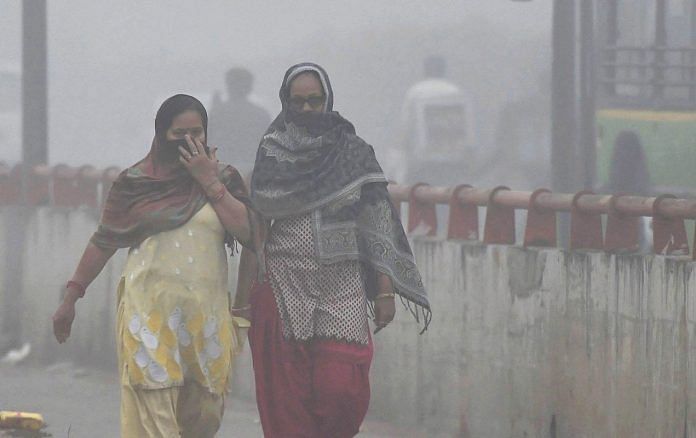Study finds the total number of deaths due to cardiovascular diseases in India increased from 15% in 1990 to 28% in 2016.
New Delhi: Incidences of heart disease have increased by more than 50 per cent among Indians, and are being aggravated by a wide-range of triggers such as “salt, sugar, fat consumption and air pollution”, a study published in The Lancet Global Health journal has highlighted.
The study has also revealed that more than half the total cardiovascular disease deaths in the country in 2016 were among people less than 70 years old.
Also read: One in every 3 women who commit suicide globally is an Indian
The study, titled ‘Global Burden of Disease Study 1990-2016’, has pointed out several other aspects of the growing problem.
Worrying numbers
Cardiovascular diseases were responsible for 28 per cent of the total deaths in India in 2016, as compared to 15 per cent in 1990. Deaths due to cardiovascular diseases in India increased from 1.3 million in 1990 to 2.8 million in 2016.
Heart diseases contributed 17.8 per cent of total deaths (19.6 per cent among men and 15.6 per cent among women), while strokes contributed 7.1 per cent of total deaths (6.9 per cent among men and 7.3 per cent among women).
India, which accounts for about 18 per cent of the world’s population, bears 23 per cent of the global disease burden for ischemic heart disease (damage in the heart’s major blood vessels).
The disability adjusted life year (DALY) rate of rheumatic heart disease (damage to one or more heart valves that remains after an episode of acute rheumatic fever) has decreased considerably over time, but India still bears 38 per cent of the global disease burden for it. One DALY can be thought of as one lost year of “healthy” life, according to the World Health Organisation.
State-wise situation
The study underlined a 50 per cent increase in ischemic heart disease and stroke from 10.2 million in 1990 to 23.8 million in 2016, with an increase observed in every state.
The prevalence of cardiovascular diseases was the highest in Kerala, Punjab and Tamil Nadu, followed by Andhra Pradesh, Himachal Pradesh, Maharashtra, Goa, and West Bengal.
Strokes were mainly prevalent in West Bengal, Meghalaya, Goa and Kerala, followed by Punjab, Himachal Pradesh, Chhattisgarh, Odisha, Andhra Pradesh and Tamil Nadu.
Ischemic heart disease has gripped Punjab, Maharashtra, Kerala and Tamil Naidu, followed by Himachal Pradesh and West Bengal.
Rheumatic heart disease was prevalent in Punjab, Chhattisgarh, Assam, Odisha, Andhra Pradesh and Kerala.
Prevalence of high systolic blood pressure (the higher number in blood pressure readings) in adults aged 30 years or older is a big problem in Punjab, Himachal Pradesh, Nagaland, Goa and Kerala, followed by Jammu & Kashmir and Uttarakhand.
Factors and expert opinion
The lead author of the study, Prof. Dorairaj Prabhakaran from the Public Health Foundation of India, pointed out: “The prevalence of cardiovascular disease risk factors such as high blood pressure, high total cholesterol, high fasting plasma glucose, and being overweight has increased across all states since 1990. Prevalence of cardiovascular diseases was highest in less-developed states.”
Experts say the reasons for heart diseases in India include air-pollution, a sedentary lifestyle and bad dietary habits.
Also read: Suicides high among married women: Crisis in Indian marriages or mental health stigma?
“India is genetically predisposed for developing coronary heart disease, while smoking, environmental factors and dietary habits are causing heart disease in people,” said Dr Nishith Chandra, director of interventional cardiology at Delhi’s Fortis Escorts Heart Institute.
“Another reason is very poor lifestyle of the younger generation, who eat unhealthy and work on computers and sit with cellphones,” he said.
“The Indian lifestyle is not active, and dietary habits are definitely a major cause. Indian diet is rich in carbohydrates and fats, and refined or trans-fats are a major cause behind this.”
While smoking was a major factor behind cardiovascular diseases, it has decreased in prevalence, suggesting that the implementation of the Cigarette and Other Tobacco Products Act in 2003 and the National Tobacco Control Programme launched in 2007 has had an effect. The study, however, said sustained efforts are needed for further progress.
“There is a decline in tobacco use and smoking. A reduction in salt and sugar consumption and air-pollution can help (prevent these diseases). But we cannot get away from the fact that these diseases have to be managed by primary health centres,” said Prabhakaran.
The Centre’s much-talked about Ayushman Bharat scheme is set to launch on 25 September, and envisions the establishment of 1,50,000 health and wellness centres across the country to provide comprehensive primary health-care services. If implemented correctly, they may play a vital role in preventing further growth of India’s heart epidemic.




Sobering and concerning data. The increased mortality is partially due to an increase in the atypical presentations of CAD. Most presents don’t present with chest pain (typical/atypical), they present with gastric symptoms, acute weakness, etc. This is commonly misdiagnosed by both the victim and the caregiver. Unless the government shoulders the responsibility, it is hard to contain the rapidly rising epidemic. A wake-up call indeed.